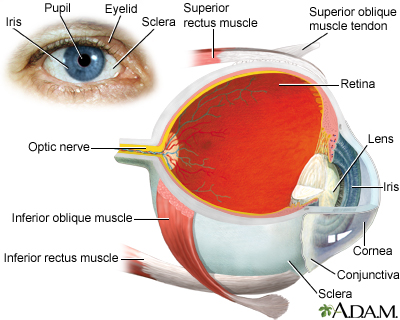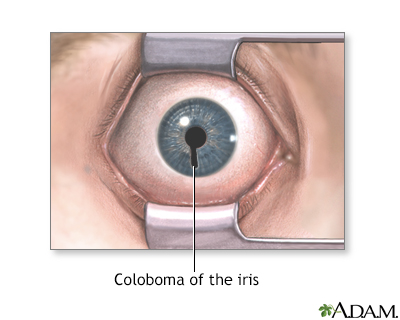Coloboma of the iris
Keyhole pupil; Cat eye syndrome; Iris defect
Coloboma of the iris is a hole or defect of the

The eye is the organ of sight, a nearly spherical hollow globe filled with fluids (humors). The outer layer or tunic (sclera, or white, and cornea) is fibrous and protective. The middle layer (choroid, ciliary body and the iris) is vascular. The innermost layer (the retina) is nervous or sensory. The fluids in the eye are divided by the lens into the vitreous humor (behind the lens) and the aqueous humor (in front of the lens). The lens itself is flexible and suspended by ligaments which allow it to change shape to focus light on the retina, which is composed of sensory neurons.

A coloboma is a defect in the iris of the eye. It can appear as a black notch of varying depth at the edge of the pupil, giving the pupil an irregular shape. Coloboma may be associated with hereditary conditions, trauma to the eye, or eye surgery.
Considerations
Coloboma of the iris can look like a second pupil or a black notch at the edge of the pupil. This gives the pupil an irregular shape. It can also appear as a split in the iris from the pupil to the edge of the iris.
A small coloboma (especially if it is not attached to the pupil) may allow a second image to focus on the back of the eye. This may cause:
- Blurred vision
- Decreased visual acuity
- Double vision
- Ghost image
If it is congenital, the defect may include the retina, choroid, or optic nerve.
Most colobomas are diagnosed at birth or shortly afterward.
Causes
Most cases of coloboma have no known cause and are not related to other abnormalities. Some are due to a specific genetic defect. A small number of people with coloboma have other inherited developmental problems.
When to Contact a Medical Professional
Contact your health care provider if:
- You notice that your child has what appears to be a hole in the iris or an unusual-shaped pupil.
- Your child's vision becomes blurred or decreased.
In addition to your child, you may also need to see an eye specialist (ophthalmologist).
What to Expect at Your Office Visit
Your provider will take a medical history and do an exam.
Since the problem is most often diagnosed in infants, knowing about the family history is very important.
The provider will do a detailed eye exam that includes looking into the back of the eye while the eye is dilated. An MRI of the brain, eyes, and connecting nerves may be done if other problems are suspected.
References
Brodsky MC, Houghton O. Congenital optic disc anomalies. In: Yanoff M, Duker JS, eds. Ophthalmology. 6th ed. Philadelphia, PA: Elsevier; 2023:chap 9.5.
Freund KB, Sarraf D, Mieler WF, Yannuzzi LA. Congenital and developmental anomalies of the optic nerve. In: Freund KB, Sarraf D, Mieler WF, Yannuzzi LA, eds. The Retinal Atlas. 2nd ed. Philadelphia, PA: Elsevier; 2017:chap 15.
National Eye Institute (NIH) website. Coloboma.
Olitsky SE, Marsh JD. Abnormalities of pupil and iris. In: Kliegman RM, St. Geme JW, Blum NJ, Shah SS, Tasker RC, Wilson KM, eds. Nelson Textbook of Pediatrics. 21st ed. Philadelphia, PA: Elsevier; 2020:chap 640.
Porter D. American Academy of Ophthalmology website. What is a coloboma?
Selzer EB, Blain D, Hufnagel RB, Lupo PJ, Mitchell LE, Brooks BP. Review of evidence for environmental causes of uveal coloboma. Surv Ophthalmol. 2022;67(4):1031-1047. PMID: 34979194
Version Info
Last reviewed on: 11/8/2023
Reviewed by: Franklin W. Lusby, MD, Ophthalmologist, Lusby Vision Institute, La Jolla, CA. Also reviewed by David C. Dugdale, MD, Medical Director, Brenda Conaway, Editorial Director, and the A.D.A.M. Editorial team.
